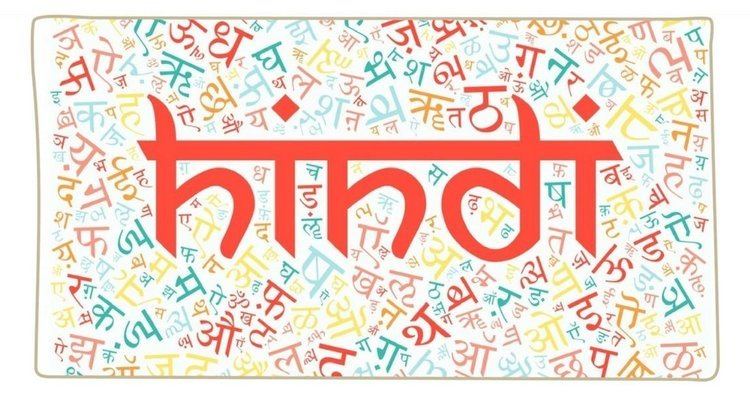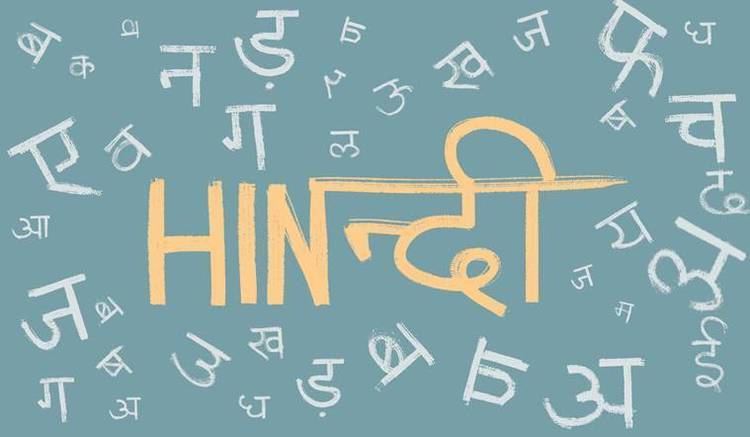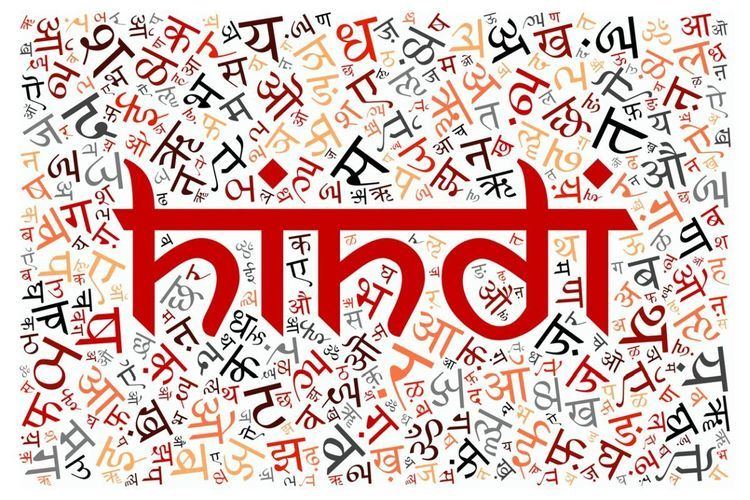Signed forms Signed Hindi Native speakers 180 million | ISO 639-1 hi Regulated by Central Hindi Directorate | |
 | ||
Early forms Vedic Sanskrit, Classical Sanskrit, Old Hindi Recognised minority language in Mauritius Suriname (as Sarnami Hindoestani), Guyana (as Guyanese Hindustani), Trinidad and Tobago (as Trinidadian Hindustani) Official language in | ||
Learn hindi hindi in three minutes self introduction
Hindi (Devanagari: हिन्दी, Hindī), or Modern Standard Hindi (Devanagari: मानक हिन्दी, Mānak Hindī) is a standardised and Sanskritised register of the Hindustani language. Along with the English language, Hindi written in the Devanagari script, is the official language of the Government of India. It is also one of the 22 scheduled languages of the Republic of India.
Contents
- Learn hindi hindi in three minutes self introduction
- Introduction to Hindi Grammar
- Official status
- Outside India
- History
- Comparison with Modern Standard Urdu
- Script
- Romanization
- Vocabulary
- Sanskrit
- Persian
- Arabic
- Literature
- Internet
- Sample text
- References
Hindi is the lingua franca of the so-called Hindi belt of India. Outside India, it is an official language in Fiji, and is a recognised regional language in Mauritius, Suriname, Guyana, and Trinidad and Tobago.

Hindi is the fourth most-spoken first language in the world, after Standard Mandarin Chinese, Spanish and English. Apart from specialized vocabulary, Hindi is mutually intelligible with Standard Urdu, another recognized register of Hindustani.
Introduction to Hindi Grammar
Official status

Part XVII of the Indian Constitution deals with Official Language. Under Article 343, official language of the Union has been prescribed, which includes Hindi in Devanagari script and English.
Gujarat High Court, in 2010, has observed that there was nothing on record to suggest that any provision has been made or order issued declaring Hindi as a national language of India.

Article 343 of the Indian constitution states
(1) The official language of the Union shall be Hindi in Devanagari script. The form of numerals to be used for the official purposes of the Union shall be the international form of Indian numerals.
(2) Notwithstanding anything in clause (1), for a period of fifteen years from the commencement of this Constitution, the English language shall continue to be used for all the official purposes of the Union for which it was being used immediately before such commencement: Provided that the President may, during the said period, by order authorize the use of the Hindi language in addition to the English language and of the Devanagari form of numerals in addition to the international form of Indian numerals for any of the official purposes of the Union
Article 351 of the Indian constitution states
It shall be the duty of the Union to promote the spread of the Hindi language, to develop it so that it may serve as a medium of expression for all the elements of the composite culture of India and to secure its enrichment by assimilating without interfering with its genius, the forms, style and expressions used in Hindustani and in the other Languages of India specified in the Eighth Schedule, and by drawing, wherever necessary or desirable, for its vocabulary, primarily on Sanskrit and secondarily on other languages.
It was envisioned that Hindi would become the sole working language of the Union Government by 1965 (per directives in Article 344 (2) and Article 351), with state governments being free to function in the language of their own choice. However, widespread resistance to the imposition of Hindi on non-native speakers, especially in South India (such as the those in Tamil Nadu), Maharashtra, Andhra Pradesh and West Bengal, led to the passage of the official languages Act of 1963, which provided for the continued use of English indefinitely for all official purposes, although the constitutional directive for the Union Government to encourage the spread of Hindi was retained and has strongly influenced its policies.
At the state level, Hindi is the official language of the following Indian states: Bihar, Chhattisgarh, Haryana, Himachal Pradesh, Jharkhand, Madhya Pradesh, Rajasthan, Uttar Pradesh, and Uttarakhand. Each may also designate a "co-official language"; in Uttar Pradesh, for instance, depending on the political formation in power, this language is generally Urdu. Similarly, Hindi is accorded the status of official language in the following Union Territories: Andaman & Nicobar Islands, Chandigarh, Dadra & Nagar Haveli, Daman & Diu, National Capital Territory.
National-language status for Hindi is a long-debated theme. An Indian court clarified that Hindi is not the national language of India because the constitution does not mention it as such.
Outside India
Outside Asia, Hindi is an official language in Fiji as per the 1997 Constitution of Fiji, where it referred to it as "Hindustani", however in the 2013 Constitution of Fiji, it is simply called "Hindi". It is spoken by 380,000 people in Fiji.
Hindi is also spoken by a large population of Madheshis (people having roots in north-India but have migrated to Nepal over hundreds of years) of Nepal. Hindi is quite easy to understand for some Pakistanis, who speak Urdu, which, like Hindi, is part of Hindustani. Apart from this, Hindi is spoken by the large Indian diaspora which hails from, or has its origin from the "Hindi Belt" of India. A substantially large North Indian diaspora lives in countries like The United States of America, the United Kingdom, Trinidad and Tobago, Guyana, Suriname, South Africa, Fiji and Mauritius, where it is natively spoken at home and among their own Hindustani-speaking communities. Outside India, Hindi speakers are 8 million in Nepal; 649,000 in United States of America; 450,170 in Mauritius; 380,000 in Fiji; 250,292 in South Africa; 150,000 in Suriname; 100,000 in Uganda; 45,800 in United Kingdom; 20,000 in New Zealand; 20,000 in Germany; 16,000 in Trinidad and Tobago; 3,000 in Singapore.
History
Like other Indo-Aryan languages, Hindi is considered to be a direct descendant of an early form of Sanskrit, through Sauraseni Prakrit and Śauraseni Apabhraṃśa. It has been influenced by Dravidian languages, Turkic languages, Persian, Arabic, Portuguese and English. Hindi emerged as Apabhramsha (Sanskrit:अपभ्रंश; Corruption or corrupted speech), a degenerated form of Prakrit, in the 7th century A.D. By the 10th century A.D., it became stable. Braj Bhasha, Bhojpuri, Awadhi, Khari Boli etc. are the dialects of Hindi. As a form of Hindustani, Standard Hindi is based on the Khariboli dialect, the vernacular of Delhi and the surrounding region. Urdu – another form of Hindustani – acquired linguistic prestige in the later Mughal period (1800s). In the late 19th century, a movement to develop Hindi as a standardised form of Hindustani separate from Urdu took form. In 1881, Bihar accepted Hindi as its sole official language, replacing Urdu, and thus became the first state of India to adopt Hindi.
After independence, the Government of India instituted the following conventions:
The Constituent Assembly adopted Hindi as an official language of India on 14 September 1949. Now, it is celebrated as Hindi Day.
Comparison with Modern Standard Urdu
Linguistically, Hindi and Urdu are two registers of the same language. Hindi is written in the Devanagari script and uses more Sanskrit words, whereas Urdu is written in the Perso-Arabic script and uses more Arabic and Persian words. Hindi is the most commonly used official language in India. Urdu is used as an additional official language in some states and is one of the 22 official languages of India.
Script
Hindi is written in the Devanagari script, an abugida. Devanagari consists of 11 vowels and 33 consonants and is written from left to right.
Romanization
The Government of India uses Hunterian transliteration as its official system of writing Hindi in the Latin script. Various other systems also exist, such as IAST, ITRANS and ISO 15919.
Vocabulary
Traditionally, Hindi words are divided into five principal categories according to their etymology:
Sanskrit
Much of Modern Standard Hindi's vocabulary is derived from Sanskrit, either as native Tadbhav words or tatsam borrowings from Sanskrit, especially in technical and academic fields. The Hindi standard, from which much of the Persian, Arabic and English vocabulary has been replaced by neologisms compounding tatsam words, is called Shuddh Hindi (pure Hindi), and is viewed as a more prestigious dialect over other more colloquial forms of Hindi.
Excessive use of tatsam words creates problems for native speakers. They may have Sanskrit consonant clusters which do not exist in native Hindi. The educated class of India may be able to pronounce such words, but others have difficulty. Persian and Arabic vocabulary given 'authentic' pronunciations cause similar difficulty.
Persian
Hindi also features significant Persian influence, standardised from spoken Hindustani.
Arabic
Arabic also shows influence in Hindi, often via Persian but sometimes directly.
Literature
Hindi literature is broadly divided into four prominent forms or styles, being Bhakti (devotional – Kabir, Raskhan); Shringar (beauty – Keshav, Bihari); Virgatha (extolling brave warriors); and Adhunik (modern).
Medieval Hindi literature is marked by the influence of Bhakti movement and the composition of long, epic poems. It was primarily written in other varieties of Hindi, particularly Avadhi and Braj Bhasha, but also in Khariboli. During the British Raj, Hindustani became the prestige dialect. Hindustani with heavily Sanskritised vocabulary or Sahityik Hindi (Literary Hindi) was popularised by the writings of Swami Dayananda Saraswati, Bhartendu Harishchandra and others. The rising numbers of newspapers and magazines made Hindustani popular with the educated people.
Chandrakanta, written by Devaki Nandan Khatri in 1888, is considered the first authentic work of prose in modern Hindi. The person who brought realism in the Hindi prose literature was Munshi Premchand, who is considered as the most revered figure in the world of Hindi fiction and progressive movement.
The Dwivedi Yug ("Age of Dwivedi") in Hindi literature lasted from 1900 to 1918. It is named after Mahavir Prasad Dwivedi, who played a major role in establishing the Modern Hindi language in poetry and broadening the acceptable subjects of Hindi poetry from the traditional ones of religion and romantic love.
In the 20th century, Hindi literature saw a romantic upsurge. This is known as Chhayavaad (shadowism) and the literary figures belonging to this school are known as Chhayavaadi. Jaishankar Prasad, Suryakant Tripathi 'Nirala', Mahadevi Varma and Sumitranandan Pant, are the four major Chhayavaadi poets.
Uttar Adhunik is the post-modernist period of Hindi literature, marked by a questioning of early trends that copied the West as well as the excessive ornamentation of the Chhayavaadi movement, and by a return to simple language and natural themes.
Internet
The Hindi Wikipedia was the first Indic-language wiki to reach 100,000 articles.
Sample text
The following is a sample text in High Hindi, of the Article 1 of the Universal Declaration of Human Rights (by the United Nations):
